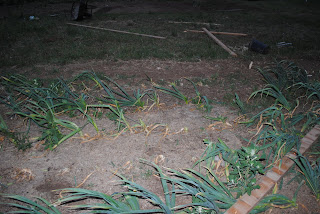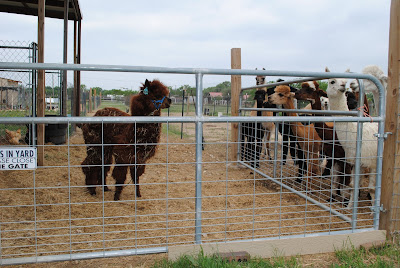Our jobs moved from Arizona to Texas and when we packed up the house, the chickens came along. They traveled in dog crates in the back of the Impala and the Suburban. They were part of the family and we weren't going to leave them behind.
When the Fleece Fur and Feathers farm become an official business entity and our flock expanded, it was harder to keep track of who was who, especially when they all looked alike. We could still recognize our Arizona girls and they had a special place in our hearts, surviving the long trip and a stray dog attack on arrival. A couple of those hens are still with us.
We have about 50 birds now and we band them so we can distinguish birth dates to know how old they are and how much longer we can expect them to lay. For the most part, they don't have names. The troublemakers and the 2 roosters are exceptions. We've hatched lots of babies and sold most of them to people wanting to add to or start their own flocks. We've also sold to people who want to butcher and eat them, something we hadn't done yet.
Though all of our hatches, we didn't have a rooster mature. Sales had taken care of that. Until last week. One of our 14 week old birds, who we were fairly certain was male, attempted to mate with one of the younger birds. He had to go. Our 2 resident roosters are plenty for the flock and this boy was obviously going to be a problem.
Chet had butchered a couple of older birds before, but we didn't eat them. The older the bird, the tougher the meat. I kept the meat and used it for training treats for the dogs.
We're not vegetarians. We try to eat local foods. Our meat purchases in the last year have been locally raised and slaughtered animals from local ranchers; nothing from the grocery store. Our vegetables come from our garden. Just a short step from eating chicken from our own flock, and one we decided to take.
The guys did the killing and cleaning over the weekend and last night I roasted the bird. It was, by far, the best chicken meat I've ever had. Can't get much fresher and the meat was tender and moist. It was smaller than a typical roaster bought in the store since it wasn't a "meat bird", but it was enough to feed the 3 of us.
This animal lived its entire life with grass under its feet, eating what chickens are meant to eat; no hormones, vaccines or antibiotics injected in its system. It enjoyed fresh air and freedom, the company of other birds, being part of a family unit, flapping its wings and flying around once in a while. You can't say that about any commercially produced chicken. While it was a bit weird preparing the bird for cooking, it's something that I know I'll do again. It's the way this country used to eat, the way my dad describes his Sunday meals when he was a boy.
So, in honor of this bird, here's his photo. Yes, he had a face, but so did all those who end up in the meat aisle at Krogers. We still enjoy watching our birds each evening, but realize in order to have a sustainable homestead, everyone's got to make a contribution. This guy definitely did.
 |
| Thank you. |

























